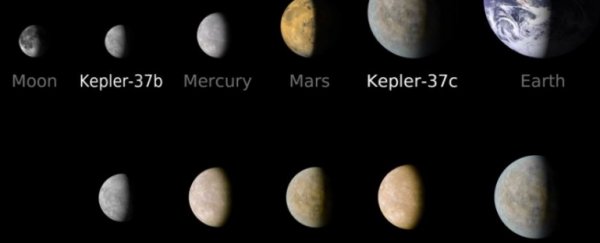A team of researchers has found what they believed is the oldest Earth-sized planet in the Milky Way, orbiting a star around 117 light-years away.
The star system, known as KOI-3158, was observed by NASA's Kepler telescope, and contains five planets similar in size to Earth, with K3158.05 being the closest to our home planet.
Interestingly, the star system is estimated to be around 11.2 billion years old (give or take 900 million years) - this makes it the oldest system known to contain Earth-sized planets in our galaxy, and suggests that Earth-like planets formed throughout the history of the Universe.
To put that into perspective, our own Solar System is only thought to be less than 5 billion years old.
But what the scientists find most interesting is that the star in KOI-3158 is iron-poor. This is surprising, as most stars hosting small, Earth-sized planets are rich in metals, and this was thought to be one of the criteria needed for "sweet spot" planets to form.
"That implies that Earth-sized planets may have readily formed at earlier epochs in the Universe's history when metals were more scarce," said Tiago Campante, an asteroseismologist from the University of Birmingham in the Uk who led the research, in a talk given at a symposium in France in July.
"KOI-3158, a system of terrestrial-sized planets, formed when the Universe was less than 20 percent of its current age, so that suggests that Earth-sized planets may have formed throughout most of the Universe's history, leaving open the possibility for the existence of ancient life in the galaxy."
Although the planets orbiting the star in KOI-3158 are similar in size to those in our Solar System - they roughly range between the sizes of Mercury and Venus - the whole system is super compact, with the closest planet having an orbit of less than 10 days.
The diagram below show how KOI-3158 compares to our own Solar System, as well as some of the other Kepler-discovered systems out there.

As Eric Mack writes for Gizmag, there's no way to know at the moment if any of the planets in the star system hosted life at some point, but the discovery is a bit of a game changer.
"If the conditions for life exist on such ancient planets, those lifeforms may have had a few billion years headstart on us to become intelligent and even technologically advanced. They may have even had enough to time to evolve, develop advanced technology and wipe themselves out in a scenario fit for many an apocalyptic science fiction epic. Heck, they may have come and gone before our Solar System was even born."
The results from Campante's research has now been submitted to The Astrohysical Journal. Going forward, observations from other telescopes will be needed to help find out more about the system - the launch of the James Webb telescope, Hubble's successor, in 2018 will be particularly exciting for finding out more about these distant worlds.
In the meantime, the Kepler telescope, which has been responsible for finding pretty much all of the planets outside our Solar System, is back online. It was put out of commission temporarily in May last year after two of its reaction wheels, which are used to position the telescope, failed. But NASA managed to use pressure from sunlight to regain control of the telescope a few weeks ago - and, of course, it's already found another Earth-sized planet since then.
It's a pretty exciting time to be looking for hints of life in the Universe.
Watch Campante talk about the discovery at The Space Photometry Revolution symposium in Toulouse, France, in July.
Source: Gizmag
